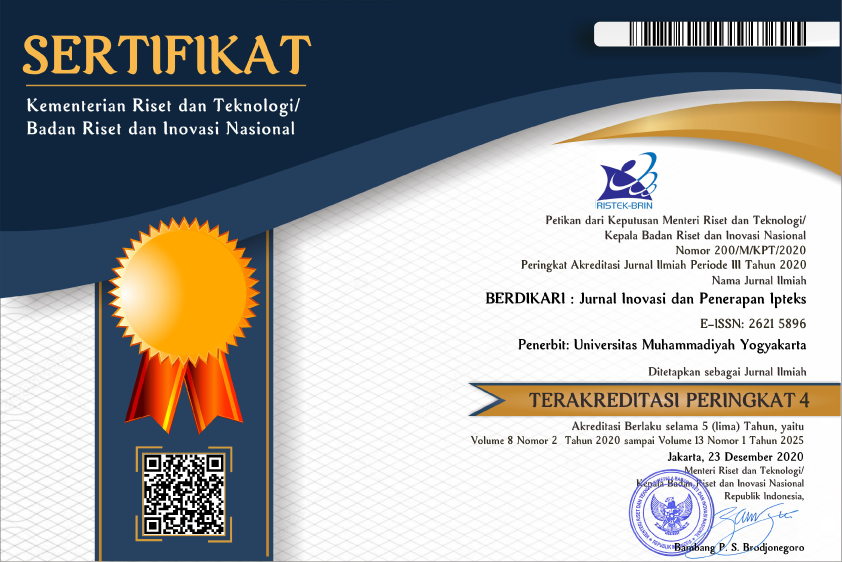Pengolahan Salep Madu Hitam Hutan Jambi untuk Perawatan Luka
DOI:
https://doi.org/10.18196/bdr.7264Keywords:
honey ointment, wound treatment, BPOMAbstract
SS. M.J Local Black Honey home production. In Pijoan Jaluko Village, Muaro Jambi Municipality is one of the black honey producers that is potentially developed to be more comparative and competitive. The development of prospective processed honey product is as health product in the form of ointment that is highly needed by people, considering that such product is not in the market yet. The development of processed honey product into health ointment by SS. M.J Local Black Honey home production has several limitations namely lacking knowledge and skill on processing, business capital, and marketing. Thus, efforts for empowerment are needed with step by step methods namely socialization, training, practice, and market meet. The success of this empowering activity is shown from the capability of SS. MJ. Local Black Honey home production to produce processed product in the form of Forest Honey Ointment, the knowledge of business capital development method, and the ability to market the product after getting license from BPOM.
References
Mandal, M.D., and Mandal, S. (2011): Honey: its medicinal property and antibacterial activity, Asian Pacific Journal of Tropical Biomedicine, 1(2): 154-160.
Walton, J., Chute, E., & Ball, L. (2011). Negotiating the role of the professional nurse: The pedagogy of simulation: A grounded theory study. Journal of Professional Nursing 27(5), 299-310. doi:10.1016/j.profnurs.2011.04.005.
Diah, M. & Rasyidah AZ. (2017). Hubungan antara Prinsip dan Jenis Balutan dengan Penerapan Tehnik Moist Wound Healing. Jurnal Endurance Kopertis Wilayah X Padang: Vol. 2, No.2.
Diah, M. & Ani, A. (2018). Drill Method to Improve Diabetic Ulcer Treatment Competency. Indonesian Nursing Journal of Education and Clinic (INJEC), Vol.3, No.1.
Lee, S. K., Pardo, M., Gaba, D., Sowb, Y., Dicker, R., Straus, E. M., . . . Knudson, M. M. (2003). Trauma assessment training with a patient simulator: A prospective, randomized study. Journal of Trauma, 55(4), 651–657.
Jeffries, P. R., & Norton, B. (2005). Selecting learning experiences to achieve curriculum outcomes. In D. M. Billings & J. A. Halstead (Eds.), Teaching in nursing: A guide for faculty (2nd ed., 187-212. St. Louis, MO: Saunders/Elsevier.
Whitman, B., & Backes, A. (2014). The importance of role direction in simulation. Clinical Simulation in Nursing, 10(6), e285-e289. doi:10.1016/j.ecns.2014.02.008Role.
Downloads
Published
Issue
Section
License
Copyright
Authors retain copyright and grant BERDIKARI Jurnal Inovasi dan Penerapan IPTEK the right of first publication with the work simultaneously licensed under an Attribution 4.0 International (CC BY 4.0) that allows others to remix, adapt and build upon the work with an acknowledgment of the work's authorship and of the initial publication in BERDIKARI Jurnal Inovasi dan Penerapan IPTEK.
Authors are permitted to copy and redistribute the journal's published version of the work (e.g., post it to an institutional repository or publish it in a book), with an acknowledgment of its initial publication in BERDIKARI Jurnal Inovasi dan Penerapan IPTEK
License
Articles published in the BERDIKARI Jurnal Inovasi dan Penerapan IPTEK) are licensed under an Attribution 4.0 International (CC BY 4.0) license. You are free to:
- Share — copy and redistribute the material in any medium or format.
- Adapt — remix, transform, and build upon the material for any purpose, even commercially.
This license is acceptable for Free Cultural Works. The licensor cannot revoke these freedoms as long as you follow the license terms. Under the following terms:
- Attribution — You must give appropriate credit, provide a link to the license, and indicate if changes were made. You may do so in any reasonable manner, but not in any way that suggests the licensor endorses you or your use.
- No additional restrictions — You may not apply legal terms or technological measures that legally restrict others from doing anything the license permits.




